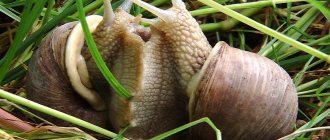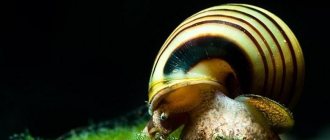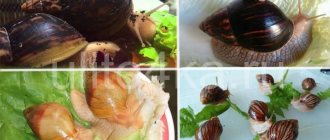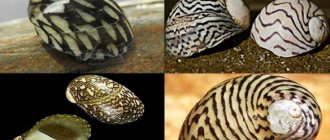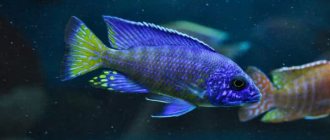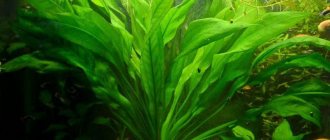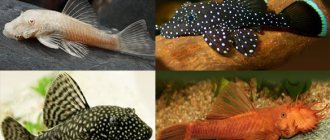Snails
Under natural conditions, the devil's thorn snail (Faunus ater) lives almost everywhere in the waters of Southeast Asia. Snails can be found in silted rivers bordering the sea coast. It is still unknown where the name of this snail came from. According to some reviews from aquarists, dead snails exude a truly devilish aroma that other snails cannot boast of, which may be how they got their name.
Faunus lava snail reaches quite a large size. An adult snail has an elongated conical, spiral-shaped shell, black or dark brown, up to 7 cm long. The apex of the shell is pointed. There are no gender differences, but these snails are not hermaphrodites; there are female and male individuals.
Devil's thorn snails are quite easy to keep. Despite the fact that snails have a rather attractive appearance, their behavior is not attractive in any way. Sometimes snails can burrow into the ground, but due to their size they cannot completely hide under it. Adults lead an inactive lifestyle and, buried in the sand, can remain there without moving for a long time. I would like to note that if you want to observe the behavior of these snails, then you should not keep them in a common aquarium with fish, because in this case, the snails will constantly hide in the ground and you will practically not see them, although according to reviews of some aquarists, snails generally do not hide anywhere, but slowly crawl along the glass of the aquarium and decorations. Due to its large size, the aquarium must also be of appropriate dimensions.
parameters should be as follows: temperature 25-28C, hardness dH 5-20, acidity pH 7.0-8.7. The water should be slightly brackish; this must be taken into account when choosing aquarium plants that can grow normally in such water.
Snails feed on algae. They especially love to eat diamond and green algae and, to a lesser extent, blue-green algae. Despite their rather large size, snails do not harm aquarium plants at all. You can also feed snails with fresh cucumbers, carrots and lettuce. They also eat apples and pears.
Description
Faunus lava snail is a fairly large mollusk. The canonical devil's shell reaches a length of 6-7 cm and a width of about 2 cm. The shell of an adult has an elongated needle-shaped cone and has about 18 spirals along its entire length.
The color of the shell is most often gloss black, although there are representatives of brown color. The body has a marbled tint, although sometimes there are individuals with a yellow or orange color. The snail's leg is round in shape, somewhat lighter than the body and has a brighter color.
Snail behavior
Devil's thorn snails are diggers and are nocturnal. They usually spend most of their time plunging into the ground and crawling along it. By doing so, they prevent the risk of hydrogen sulfide formation, which can be very dangerous for your fish or shrimp. From time to time, you may see them crawling up the glass only to slip off or free fall to the bottom. They are active everywhere both on the ground and underground. Black devil snails can uproot small plants with weak root systems.
Habitat
The range of the devil's thorn (Faunus ater) extends from the Indo-West Pacific to Australia. Stretches along the southern coast of Africa, Madagascar, southern North and South America.
This type of mollusk was found in the waters:
- Thailand
- Malaysia
- Philippines
- Sri Lanka
- Indonesia
- New Guinea
- near the islands of the western Pacific Ocean.
Prefers the mouths and lower reaches of freshwater rivers that flow into the ocean, salt ponds, lakes, lagoons and canals, and mangroves. In Java, snails of this species are found in shallow reservoirs of 1–1.5 meters with a muddy bottom, into which fresh water enters at high tides. Habitats are located near rocky ledges and sandy beaches.
Color variations and morphs
Sometimes in pet stores you can see different color morphs of this snail species. For example, "Cappuccino" (Faunus ater "Cappuccino") has a gradient shell from dark brown at the head to orange or white towards the tail.
In fact, some aquarists have serious doubts about this. The fact is that the genus Faunus is monotypic, consisting of one species - Faunus ater. According to scientific papers and studies, Faunus ater does not have color changes. They are all dark. Therefore, these snails are something other than Faunus ater.
However, there is always the possibility that scientists are wrong and this color variation will later be included in this genus.
Photos above and below are the “Cappuccino” morph
Devil's thorn care and maintenance
To keep these snails, it is recommended to add salt to the water to recreate natural habitat conditions. However, this is not necessary; the devil's thorn lives well in a freshwater aquarium without salting.
Snails are quite active, crawling along the decorations and walls of the aquarium, and are able to burrow into the soil and stir it up. Like any aquatic organisms, these snails require water changes, aeration and filtration of the aquarium; they do not tolerate high concentrations of nitrogenous compounds of poisons: ammonia, nitrite and nitrate.
For obvious reasons, snails should not be kept with tetraodon , labyrinth and other fish that are not averse to feasting on them.
The devil's thorn does not require individual feeding. It feeds on algal fouling and the remains of fish food. You can feed with food from our table: spinach, lettuce, cucumber, zucchini or tableted fish food, for example, Tetra Tablets TabiMin or Tetra Pleco Tablets.
Nutrition
In natural ecosystems, aquatic faunus participates in the cycle of substances, destroying algal fouling and organic debris. It feeds on green, blue-green and diamond algae. A tongue equipped with a grater with teeth (radula) separates the layer of algae from the substrate.
Water parameters
The devil's thorn is kept in an aquarium with certain parameters of the aquatic environment:
- optimal temperature 25-28C
- the acidity of the medium is determined by pH 7.0-8.7.
- water hardness dH 5-20.
- the water should be salty (1 tablespoon of sea salt per 3 liters of water).
Compatibility with other aquarium inhabitants
Any peaceful fish will be suitable as neighbors: platies, mollies, corydoras, guppies, otocinclus, algae eaters, etc.
You should not house the devil's thorn with loaches, tetradons, or predatory cichlids; these fish feed on snails or will damage them during excavation.
Reproduction
The devil's thorn snail is not a hermaphrodite, which means that successful reproduction requires the presence of individuals of both sexes. In its natural habitat, the devil breeds exclusively in salt water, so in order to produce offspring at home, the presence of salt water is also required. The devil's thorn is a viviparous snail, but for successful reproduction, both the individuals themselves and the young must be in salt water.
The devil's thorn snail has recently interested many collectors of rare species of mollusks. Aquatic inhabitants are distinguished by a variety of shell shapes and colors. Experts call it devil's horn, black faun, aquatic faunus. This is an aquatic, hardy gastropod species that is attracted by its large and cone-shaped shell with a pointed apex. The origin of the species name is associated with the presence of a spire on the shell and the unpleasant odor that appears after the death of individuals. There is only one species in the genus Faunus.
Breeding
Currently, Devil's Thorn snails are famous among lovers of marine fauna. They are attracted primarily by large specimens and a black glossy shell. In addition, this type of mollusk is not demanding in terms of living conditions and is not whimsical in nutrition. The only problem that can hardly be solved in an easy way is obtaining offspring in captivity.
The devil's thorn is famous among lovers of marine fauna
Aquatic faunas do not reproduce even under conditions as close as possible to their natural habitat. Therefore, they buy and resettle snails caught at sea. Although no special obstacles to reproduction in captivity have been noted for the devil's thorn, therefore specialists will be able to reproduce this species.
Kinds
- Madagasikara madagascarensis - tropical freshwater snail
- Madagasikara johnsoni has a large, elongated, olive-colored pyramidal turret with a thick stratum corneum. Has 9 curls with longitudinal dark stripes. Dimensions 7.0-7.7 cm. Hole height reaches 2.0 2.1 cm. Lives in the waters of Madagascar.
- Pachychilus laevissimus is a species that is found in Venezuela.
- Brotia pagodula star snail or star of India. Pagoda-shaped shell. Distributed in Southeast Asia (Myanmar, Thailand). Prefers places with strong currents in rocky areas, found on rocks near waterfalls. Dimensions 5.0 5.5 cm.
- Doryssa consolidata is a gastropod with an operculum, endemic to South America (Venezuela, Guyana).
- Jagora asperata is endemic to the Philippines. Dimensions from 5 to 8 cm, width 1.8 cm. With a hard shell of dark brown, light brown, yellowish brown color. It has the shape of a high tower with 12 scrolls. The apical helix is truncated. Axial ribs and spirals with point nodules stand out on the surface. The soft body is gray or blackish in color. It feeds on algae and detritus.
- Sulcospira agrestis - lives in Borneo, Malaysia.
- Sulcospira housei with a dark brown shiny shell covered with dark spots. Area Laos, Cambodia, Thailand, Vietnam, Myanmar.
- Sulcospira collyra has an elongated shell shape. Found in Vietnam.
Nutrition
The main diet of snails of this species consists of vegetables, offer your pet:
- apple,
- pear,
- mango,
- zucchini,
- cucumber,
- lettuce leaves.
The mollusk will not refuse algae, but the snail is largely indifferent to the vegetation of the aquarium. Sometimes, when there is a lack of food, it can eat moss in small quantities. The snail eats fish food reluctantly.
You should feed the devil two or three times a week.
Diseases
The devil's thorn snail can be affected by diseases, like all gastropods. Their metabolism is disrupted and the calcareous composition of the protective cover changes, so the water is salted using sea salt. Calcium carbonate is also added to the water in the form of pieces of chalk (feed). At low temperatures, snails reduce activity, so the temperature should not be allowed to drop below the optimal value (not lower than 20 degrees).
If the appearance of the shell changes and scratches or bumps appear, check the surface for the presence of parasites. Then the horny cover is treated with costapur. Large mollusks do not tolerate an abundance of living organisms in one tank, so you should study the species composition for compatibility and move active fish to another aquarium.
Sources:
- https://black-fish.ru/ryby/ulitka-ship-dyavola-soderzhanie-i-uhod.html
- https://proulitok.ru/vidy-ulitok/ship-dyavola-ulitka/
- https://fanfishka.ru/akvariumnye-stati/akvariumnye-ulitki/1905-ship-dyavola.html
[collapse]
Feeding
These snails are omnivores and are considered scavengers. If there are fish in the aquarium, the mollusk will eat the remaining food that has fallen to the bottom. Small algae fouling will be eaten with pleasure, but do not expect them to clean out the aquarium, as their weight is very significant and they will spend most of their time on the ground.
You can feed the snail once every three days. These can be lettuce leaves, slices of cucumber, and zucchini pre-scalded with boiling water. These additives are required, otherwise hungry snails can spoil the plants. Tablets for bottom fish are also excellent. Calcium supplements should be used to strengthen the shell.
How to keep snails: main features
The main feature of snails is their slowness. They live in various bodies of water in different countries of the world.
Snails can appear spontaneously in your aquarium, so it is not always necessary to introduce them. When purchasing algae for your aquarium, you can easily bring them into your apartment with you. But it’s one thing if these are beautiful large snails, and another thing if these are ordinary coils that are of no particular use. Moreover, they multiply uncontrollably, which can disrupt the biobalance of the closed aquarium ecosystem. Some types of snails can pose a danger to fry and even shrimp.
Keeping and caring for snails, first of all, involves maintaining the correct water characteristics. They are very picky about the condition of the water - if it is soft or acidic, then they will not have enough minerals necessary for the construction of the shell. Accordingly, the water for their habitat must be sufficiently hard and saturated with calcium.
Snails can withstand different temperatures - from 18 to 28 degrees Celsius. We recommend purchasing them from a specialized pet store.
An important point is the choice of soil, which should be fine or coarse sand (soil 1-2 mm in size is suitable). For normal living, snails, like aquarium fish, require 10 liters per individual.
